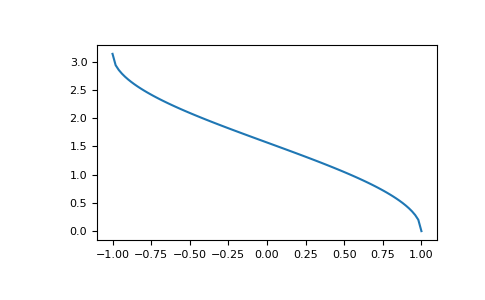numpy.arccos¶
-
numpy.arccos(x[, out]) = <ufunc 'arccos'>¶ 三角反余弦,元素方式。
使得如果
y = cos(x),则cos那么x = arccos(y)。参数: x:array_like
x - 坐标在单位圆上。对于实参,域是[-1,1]。
out:ndarray,可选
数组形状与a相同,以存储结果。有关更多详细信息,请参阅
doc.ufuncs(“输出参数”部分)。返回: angle:ndarray
在给定的x 坐标处,以弧度[0,π]与单位圆相交的射线的角度。如果x是标量,则返回标量,否则返回与x相同形状的数组。
笔记
arccos是多值函数:对于每个x,存在无限多个数字z,使得cos(z)= x t5 >。惯例是返回其实部在[0,pi]中的角度z。对于实值输入数据类型,
arccos始终返回实际输出。对于不能表示为实数或无穷大的每个值,它会产生nan并设置无效浮点错误标志。对于复值输入,
arccos是具有分支切割[ - inf,-1]和[1,inf]的复杂分析函数,并且在前者上从上方连续,在后者上从下方连续。反
cos也称为acos或cos ^ -1。参考文献
Abramowitz和I.A.Stegun,“Handbook of Mathematical Functions”,10th printing,1964,pp。79. http://www.math.sfu.ca/~cbm/aands/
例子
我们期望1的arccos为0,而-1的arccos为pi:
>>> np.arccos([1, -1]) array([ 0. , 3.14159265])
绘图arccos:
>>> import matplotlib.pyplot as plt >>> x = np.linspace(-1, 1, num=100) >>> plt.plot(x, np.arccos(x)) >>> plt.axis('tight') >>> plt.show()
